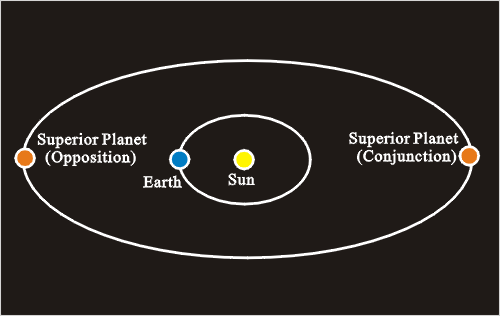Opposition of Saturn
Opposition of Saturn
Opposition of Superior Planets
A superior planet revolves around the Sun in an orbit further away from the Sun than the Earth. Mars, Jupiter, Saturn, Uranus and Neptune are superior planets in the Solar System.
When a superior planet, the Earth and the Sun align in a straight line with the Earth in between, it is known as opposition. When the superior planet and the Earth lie on the opposite sides of the Sun, it is known as conjunction (Figure 1). During opposition, the superior planet will be closest to the Earth and it would be a suitable time for observing the superior planet.

Figure 1 Relative positions of a superior planet, the Earth and the Sun during opposition and conjunction of the superior planet.
Opposition of Saturn
Saturn is the second largest planet in the Solar System and the sixth planet away from the Sun. Saturn is characterized by the Saturn ring, which is composed of icy and rocky particles.
Saturn revolves around the Sun with a period of about 29.5 years. Opposition of Saturn will occur about once every 378 days.
During the opposition, Saturn will be relatively bright, reaching a visual magnitude of about -0.5*. This will be a good time to observe Saturn and its ring structure. A telescope with 30 times or above magnification is preferred in observing Saturn.
* Visual magnitude is a measure of the brightness of a celestial object. The visual magnitude of a faint star is large and positive. The brighter a star is, the smaller the visual magnitude will be. The brightest celestial objects will have negative magnitudes (visual magnitudes for the Sun and full moon are -26.8 and -12.5 respectively). In a clear night, the faintest stars that can be observed by naked eyes in the countryside would have a magnitude of around +6.
Related links:
"Solar System Exploration", U.S. National Aeronautics and Space Administration (NASA)
"Hong Kong Observatory Almanac" (see the section "Planetary Phenomena")